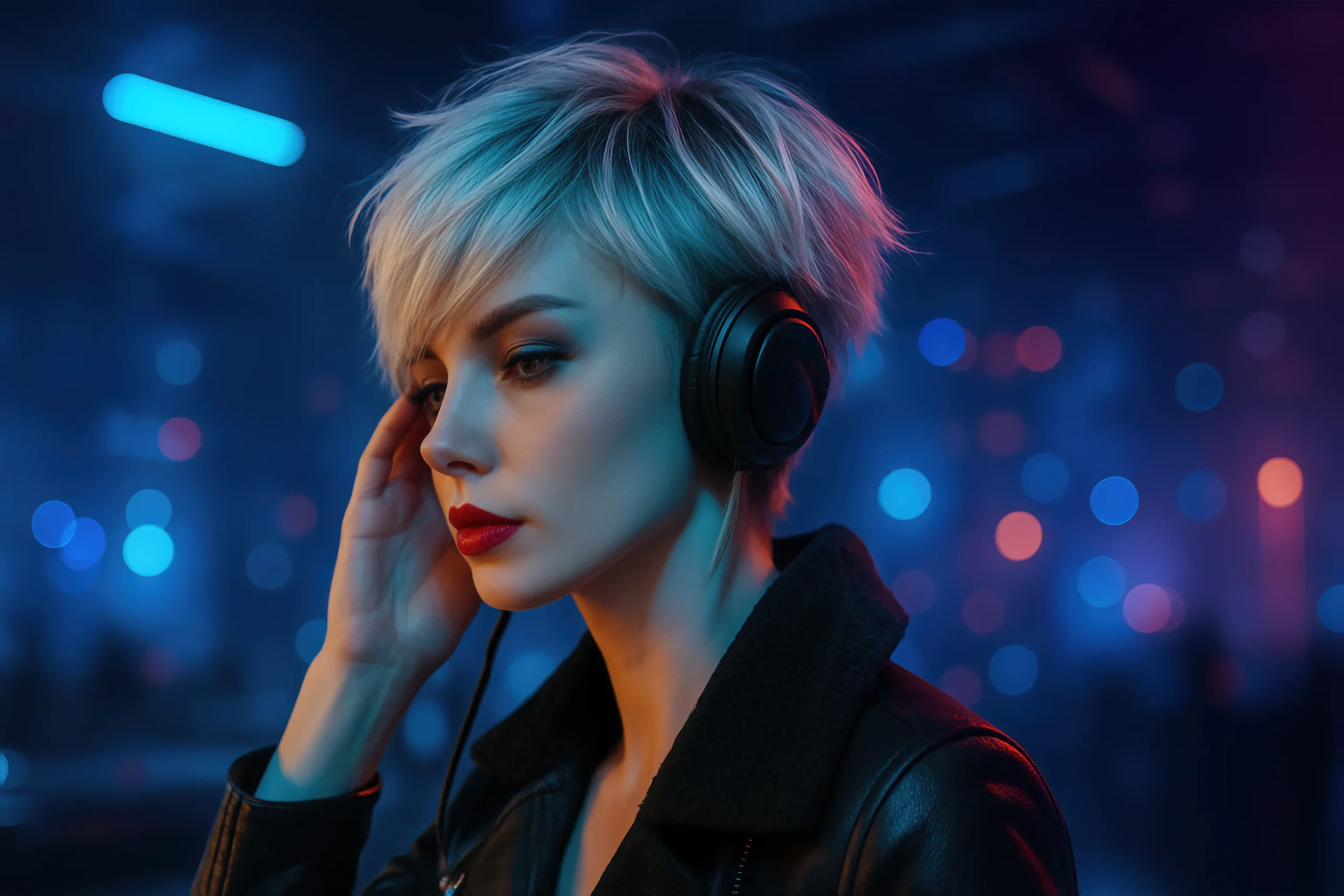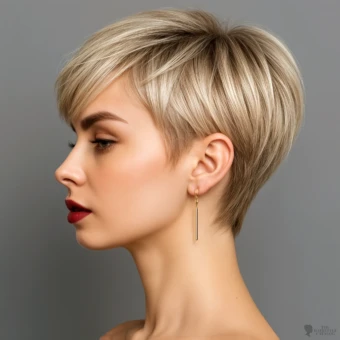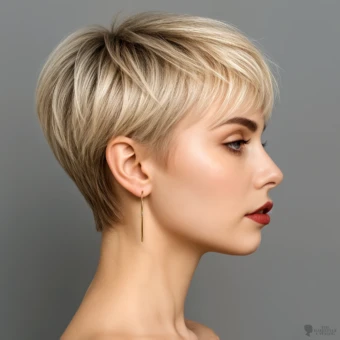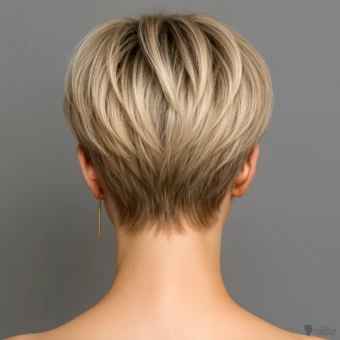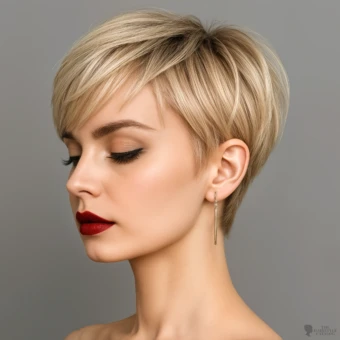Textured Pixie with Long Side Fringe – Modern Short Style
Summary
The Textured Pixie with Long Side Fringe is a short, modern cut that balances softness with edge. Longer, feathered layers through the top and a light, side-swept fringe frame the eyes, while the nape and sides are tapered for a clean silhouette. It is versatile, photogenic, and ideal for showcasing luminous color from cool platinum to warm beige blonde.
The Textured Pixie Cut with Long Side Bangs
This hairstyle is firmly in the short category, typically cut to 6–10 cm on the crown with shorter, blended lengths at the temples and nape. The shape is a rounded pixie crop with internal layering to create airy lift and natural movement. The top layers are texturized rather than blunt, which prevents bulk and gives the hair a light, tousled quality. Sides are scissored or clippered close yet soft, then over-directed into the crown so the head shape looks elegant rather than boxy.
A defining feature is the long side fringe. It is cut diagonally from the part line and feathered at the ends so it falls across the forehead without a heavy line. The parting is flexible — often a soft off-center or natural fall — and the hairline is refined around the ears and nape to maintain a feminine finish. Styling focuses on a polished-undone texture: a quick blow-dry using a flat or oval brush to direct the fringe, then a pea of lightweight paste or styling cream is worked through the tips for separation. For extra polish, a touch of serum adds sheen without collapsing the volume.
Because the perimeter is slim and the crown is softly rounded, this cut flatters oval, heart, and soft square face shapes. The sweeping fringe shortens a high forehead and draws attention to the eyes and cheekbones. It suits many occasions — editorial, professional, and evening — and pairs well with statement makeup or minimalist looks. Maintenance is every 4–7 weeks to keep the fringe length and nape contour precise.
Textured Pixie Cut with Long Side Bangs Hairstyle Overview
| Hairstyle Properties | |
|---|---|
| Alternative Names | Layered Pixie Crop, Feathered Short Pixie |
| Hairstyle Category/Subcategory | Short Hair / Pixie |
| Complexity | Moderate |
| Hairstyle Volume | Moderate Volume |
| Symmetry & Balance | |
| Texture Finish | |
| Parting/Hairline | |
| Bangs/Fringe Type | |
| Face Enhancements | |
| Hair Suitability | |
| Face Shape Suitability | |
| Hair Length Suitability | |
| Hair Structure Suitability | |
| Hair Thickness Suitability | |
| Hair Curl Pattern Suitability | |
| Hair Health Suitability | |
| Color Treatment Suitability | |
| Practicality | |
| Styling Difficulty | Easy |
| Time to Style | 10 to 15 minutes |
| Maintenance | Moderate (Requires Some Styling) |
| Durability | Up to 12 hours |
| Styling Methods | |
| Styling Tools | |
| Styling Accessories | |
| Other Properties | |
| Gender | |
| Age Group | |
| Occasion | |
| Cultural Origins | |
| Era of Popularity | |
| Special Tags | |
Origin, History & Cultural Influence
The pixie cut emerged in the mid-20th century as a shorter, fashion-forward alternative to the bob, gaining prominence in the late 1950s and 1960s through film and fashion icons who favored clean necklines and expressive eyes. Through the 1990s and 2000s, texturizing techniques and modern coloring expanded the look from a neat gamine crop into a more versatile family of silhouettes.
The textured, long-fringe variant became popular as stylists began mixing softness with structure — using razors, slide cutting, and point-cutting to create movement without losing shape. In contemporary fashion and beauty photography, the style photographs exceptionally well because the diagonal fringe and crown lift emphasize bone structure and allow creative lighting to catch the hair’s surface. Platinum and beige-blonde tones are frequent companions, since the short length keeps high-lift color manageable and shows off dimension with minimal effort.
Today, the Textured Pixie with Long Side Fringe reads as modern and feminine while remaining practical. It reflects current tastes for effortless polish — a cut that can be finger-styled in minutes, adapts to both casual and high-glam settings, and places the face at center stage.

Styling Instructions
This cut is best maintained and shaped by a professional stylist, but it can easily be styled at home once the foundation is in place. The goal is to create a light, textured finish with soft volume at the crown and a smooth, side-swept fringe that frames the face.
Step-by-Step Styling Guide
- Start with clean, towel-dried hair.
Apply a lightweight volumizing mousse or texture-enhancing spray through the roots and mid-lengths to help define the layers and create lift. - Pre-dry with your fingers.
Using a blow-dryer on medium heat, rough-dry the hair while lifting sections at the crown to encourage natural movement. Direct the airflow forward and slightly to the side to guide the fringe into place. - Refine the shape with a small round or flat brush.
Once the hair is about 70% dry, switch to a small round brush to smooth and shape the top layers. Brush the fringe diagonally across the forehead and tuck the shorter sides gently toward the ears for a clean contour. - Add definition.
Work a pea-sized amount of lightweight wax, pomade, or styling cream between your palms. Gently pinch and twist small sections around the crown and fringe to enhance the textured look. Avoid overworking the product — the finish should stay soft and touchable, not stiff. - Perfect the silhouette.
Use your fingers or a comb to ensure the crown has a subtle lift while the nape and sides remain close to the head. Mist lightly with a flexible-hold hairspray for lasting control.
Professional Tips
- A texturizing spray or dry wax works best for refreshing the look between washes without adding weight.
- Use a heat protectant before blow-drying, especially if your hair is color-treated or platinum blonde.
- Trim the fringe and nape every 4–6 weeks to keep the cut’s precision and balance.
- For added shine, finish with a drop of serum emulsified between the hands and applied lightly over the top layers.
This technique ensures a polished yet effortless finish — the essence of the modern textured pixie.

